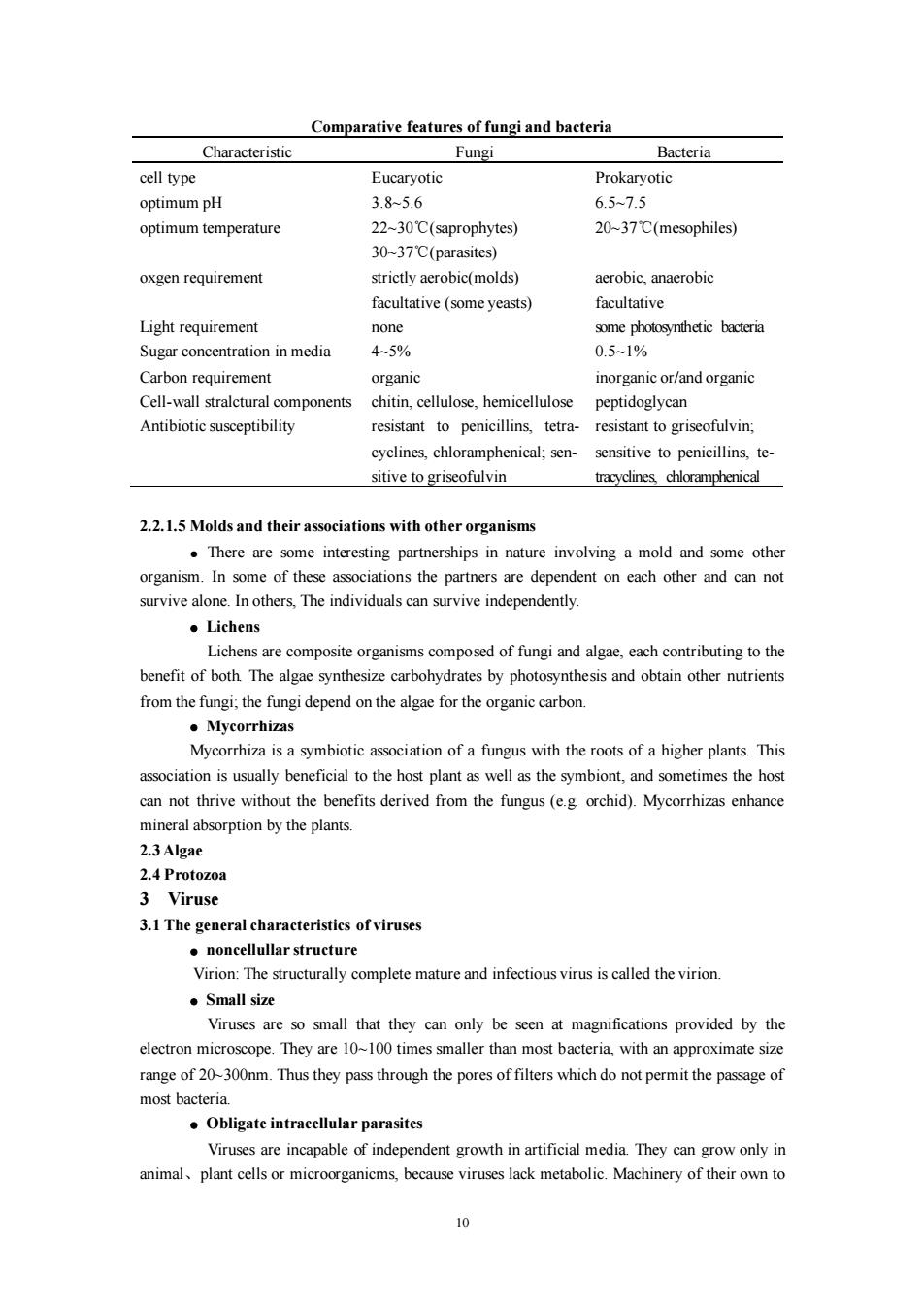正在加载图片...

10 Comparative features of fungi and bacteria Characteristic Fungi Bacteria cell type optimum pH optimum temperature oxgen requirement Light requirement Sugar concentration in media Carbon requirement Cell-wall stralctural components Antibiotic susceptibility Eucaryotic 3.8~5.6 22~30℃(saprophytes) 30~37℃(parasites) strictly aerobic(molds) facultative (some yeasts) none 4~5% organic chitin, cellulose, hemicellulose resistant to penicillins, tetracyclines, chloramphenical; sensitive to griseofulvin Prokaryotic 6.5~7.5 20~37℃(mesophiles) aerobic, anaerobic facultative some photosynthetic bacteria 0.5~1% inorganic or/and organic peptidoglycan resistant to griseofulvin; sensitive to penicillins, tetracyclines, chloramphenical 2.2.1.5 Molds and their associations with other organisms ● There are some interesting partnerships in nature involving a mold and some other organism. In some of these associations the partners are dependent on each other and can not survive alone. In others, The individuals can survive independently. ● Lichens Lichens are composite organisms composed of fungi and algae, each contributing to the benefit of both. The algae synthesize carbohydrates by photosynthesis and obtain other nutrients from the fungi; the fungi depend on the algae for the organic carbon. ● Mycorrhizas Mycorrhiza is a symbiotic association of a fungus with the roots of a higher plants. This association is usually beneficial to the host plant as well as the symbiont, and sometimes the host can not thrive without the benefits derived from the fungus (e.g. orchid). Mycorrhizas enhance mineral absorption by the plants. 2.3 Algae 2.4 Protozoa 3 Viruse 3.1 The general characteristics of viruses ● noncellullar structure Virion: The structurally complete mature and infectious virus is called the virion. ● Small size Viruses are so small that they can only be seen at magnifications provided by the electron microscope. They are 10~100 times smaller than most bacteria, with an approximate size range of 20~300nm. Thus they pass through the pores of filters which do not permit the passage of most bacteria. ● Obligate intracellular parasites Viruses are incapable of independent growth in artificial media. They can grow only in animal、plant cells or microorganicms, because viruses lack metabolic. Machinery of their own to10 Comparative features of fungi and bacteria Characteristic Fungi Bacteria cell type optimum pH optimum temperature oxgen requirement Light requirement Sugar concentration in media Carbon requirement Cell-wall stralctural components Antibiotic susceptibility Eucaryotic 3.8~5.6 22~30℃(saprophytes) 30~37℃(parasites) strictly aerobic(molds) facultative (some yeasts) none 4~5% organic chitin, cellulose, hemicellulose resistant to penicillins, tetracyclines, chloramphenical; sensitive to griseofulvin Prokaryotic 6.5~7.5 20~37℃(mesophiles) aerobic, anaerobic facultative some photosynthetic bacteria 0.5~1% inorganic or/and organic peptidoglycan resistant to griseofulvin; sensitive to penicillins, tetracyclines, chloramphenical 2.2.1.5 Molds and their associations with other organisms ● There are some interesting partnerships in nature involving a mold and some other organism. In some of these associations the partners are dependent on each other and can not survive alone. In others, The individuals can survive independently. ● Lichens Lichens are composite organisms composed of fungi and algae, each contributing to the benefit of both. The algae synthesize carbohydrates by photosynthesis and obtain other nutrients from the fungi; the fungi depend on the algae for the organic carbon. ● Mycorrhizas Mycorrhiza is a symbiotic association of a fungus with the roots of a higher plants. This association is usually beneficial to the host plant as well as the symbiont, and sometimes the host can not thrive without the benefits derived from the fungus (e.g. orchid). Mycorrhizas enhance mineral absorption by the plants. 2.3 Algae 2.4 Protozoa 3 Viruse 3.1 The general characteristics of viruses ● noncellullar structure Virion: The structurally complete mature and infectious virus is called the virion. ● Small size Viruses are so small that they can only be seen at magnifications provided by the electron microscope. They are 10~100 times smaller than most bacteria, with an approximate size range of 20~300nm. Thus they pass through the pores of filters which do not permit the passage of most bacteria. ● Obligate intracellular parasites Viruses are incapable of independent growth in artificial media. They can grow only in animal、plant cells or microorganicms, because viruses lack metabolic. Machinery of their own to